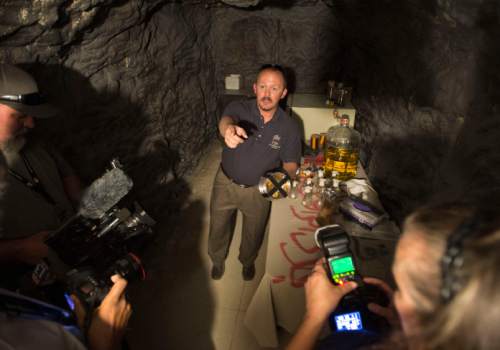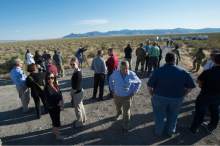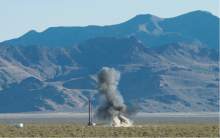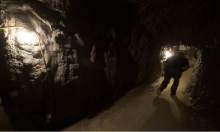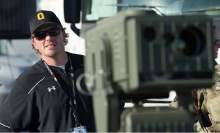This is an archived article that was published on sltrib.com in 2016, and information in the article may be outdated. It is provided only for personal research purposes and may not be reprinted.
Dugway Proving Ground • As the sun set Wednesday on Utah's West Desert, Brian Tercha stood beside his chemical-weapon sensor.
The sensor is about the size of a toaster oven. It oscillates on a tripod and shoots infrared rays to detect signs of toxins in the air. As he waited for an explosion that would send chemicals into the wind for a test, Tercha explained his sensor system to about a dozen middle-age white men from the U.S. Department of Defense and other government agencies.
"It's a marketing opportunity," Tercha explained a few minutes later.
Tercha's company, called Mesh, Inc., from Oxford, Penn., is one of the firms at Dugway this week for the annual S/K Challenge. It's an opportunity for private contractors to show off their scientific products to the U.S. military. It's also an opportunity for Dugway to show off its facilities to the private contractors.
The U.S. Army uses Dugway to test defenses against biological and chemical weapons and to test new conventional weapons systems. Companies wanting to test their products here typically have to pay, explained Kenneth Gritton, the technical director at Dugway. He said that money goes into Dugway's budget. The testing at Dugway also allows the Army to judge for itself how well products work. Gritton on Wednesday was speaking to reporters in a test chamber 31/2 stories tall, 550 long and 50 feet wide that allows for controlling environmental conditions. Gritton said the Army uses the chamber to test how chemicals and biological agents affect everything from clothing and tents to vehicles, as well as sensors. "If you can see the threat before you get into it," Gritton said, "that's a great win."
Dugway on Wednesday also showed off some of its testing facilities to reporters. A few miles from Dugway's gate, the Army has constructed a mock tunnel out of 15 shipping containers. The containers were fastened together with wooden frames and insulation foam. Lights hung from the ceiling, though Lance McEntire, one of the scientists at Dugway, said they are sometimes shut off to allow soldiers to train in the dark.
Inside the mock tunnel, soldiers learn to search for and identify weapons of mass destruction. In one tunnel alcove, journalists had to guess whether the equipment before them was intended to construct a chemical, biological or nuclear weapon. A trained observer would have seen the petri dishes and realized someone had been making bacteria.
McEntire said he will sometimes sprinkle the mock weapons labs with documents written in foreign languages and add other nuances to the training. He just can't put any real chemical, biological or nuclear agents in the tunnel.
"It's as realistic as we can make it," McEntire said.
Later in the afternoon, at a spot called Target S, Tercha waited for the detonation. Explosives were set beside some chemical containers about a mile away. The compounds were benign, but they had structures similar to what's found in some chemical weapons, thus providing a suitable test for the many sensors, like Tercha's, that were aimed on the target.
Tercha hopes the military buys his sensor as a warning system for forward operating units. As the explosion went off, Tercha was speaking to an Army colonel. Officers from the Air Force and Marines were among the crowd of onlookers.
Tercha said it could be months before he knows how well his sensor performed in the test.
"What translates into interest from the government is hard to say," Tercha said.
Twitter: @natecarlisle









